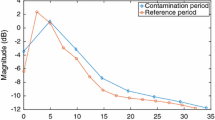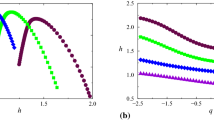Abstract
Amplitude-modulated processes can be formally presented as a product of two or more sinusoids. This makes it possible to study them by means of analysis of multiplicative phenomena using the Fast Fourier Transform (FFT). To assess the contribution of amplitude EEG modulation to the dynamic of electrical activity of the human brain, the results of the FFT of simulated signals obtained by multiplication of oscillatory processes with different parameters were compared with the results of the FFT of a single EEG recording from a subject at rest. We studied the temporal dynamics of spectral components calculated with different spectral resolution under similar conditions for real and simulated signals. An attempt was made to analyze and interpret the amplitude-modulated EEG processes using the additive properties of the FTT. It was shown that processes of amplitude modulation are present in electrical brain activity and determine the synchronism of changes in time in the majority of frequency components of the EEG spectrum. The presence of the amplitude modulation in bioelectrical processes is of a fundamental nature, since it is a direct reflection of the control, synchronization, regulation, and intersystem interaction in the nervous and other body systems. The study of this modulation gives a clue to the mechanisms of these processes.
Similar content being viewed by others
References
Ivanitskii, A.M., Podkletnova, I.M., and Taratynova, G.V., Study of the Dynamics of the Intracortical Interaction during Thinking Activity,Zh. Vyssh. Nervn. Deyat. im. I.P. Pavlova, 1990, vol. 40, no. 2, p. 230.
Ivanitskii, A.M., Foci of Interaction, Synthesis of Information, and Mental Activity,Zh. Vyssh. Nervn. Deyat. im. I.P. Pavlova, 1993, vol. 43, issue 2, p. 219.
Ivanitskii, A.M., Brain Substrate of Subjective Experimence: A Hypothesis of Information Synthesis,Zh. Vyssh. Nervn. Deyat. im. I.P. Pavlova, 1996, vol. 46, no. 2, p. 241.
Sviderskaya, N.E. and Shlitner, L.M., Coherent Structures of Electrical Activity of the Human Cerebral Cortex,Fiziol. Chel., 1990, vol. 16, no. 3, p. 12.
Sviderskaya, N.E. and Korol’kova, T.A., Spatial Organization of Brain Electrical Processes: Problems and Solutions,Zh. Vyssh. Nervn. Deyat. im. I.P. Pavlova, 1997, vol. 47, no. 5, p. 792.
Shepoval’nikov, A.N., Tsitseroshin, M.N., and Pogosyan, A.A., On Some Principles of Integration of Bioelectrical Activity of Spatially Distributed Neocortical Regions into a Single System,Fiziol. Chel., 1995, vol. 21, no. 5, p. 36.
Aladzhalova, N.A.,Psikhofiziologicheskie aspekty sverkhmedlennoi ritmicheskoi aktivnosti golovnogo mozga (Psychophysiological Aspects of the Superslow Rhythmical Brain Activity), Moscow: Nauka, 1979.
Ilyukhina, V.A., Khabaeva, Z.G., Nikitina, L.I.,et al., Sverkhmedlennye fiziologicheskie protsessy i mezhsistemnoe vzaimodeistvie v organizme (Superslow Physiological Processes and Intersystem Interaction in the Organism), Leningrad: Nauka, 1986.
Zufrin, A.M., Il’in, S.B., Kachan, A.T., and Bogdanov, N.N., Dynamics of Modulatory Superslow Waves in the EEG and ECG at Low-intensity Infrared Illumination of the “Heart” Acupuncture Point on the Auricle,Fiziol. Chel., 1990, vol. 16, no. 6, p. 219.
Frolov, M.V., Mekhedova, A.Ya., and Milovanova, G.B., Detection of the Superslow Fluctuations of Brain Potentials: Method and Results,Fiziol. Chel., 1997, vol. 23, no. 4, p. 127.
Novak, P., Lepicovska, V., and Dostalek, C., Periodic Amplitude Modulation of EEG,Neurosci. Let., 1992, vol. 136, no. 2, p. 213.
Novak, P., Novak, V., Li, Z., and Remillard, G., Time-Frequency Analysis of Slow Cortical Activity and Cardiovascular Fluctuations in a Case of Alzheimer’s Disease,Clin. Auton. Res., 1994, vol. 4, no. 3, p. 141.
Achermann, P. and Borbely, A.A., Low-frequency (<1 Hz) Oscillations in the Human Sleep Electroencephalogram,Neuroscience, 1997, vol. 81, no. 1, p. 213.
Astaf’eva, N.M., Wavelet Analysis: Theoretical Fundamentals and Examples of Application,Usp. Fiziol. Nauk, 1996, vol. 166, no. 11, p. 1145.
Kulaichev, A.P., Some Methodological Problems of the EEG Frequency Analysis,Zh. Vyssh. Nervn. Deyat., 1997, vol, 47, no. 5, p. 918.
Kaplan, A.Ya., The Problem of Segmentary Description of the Human EEG,Fiziol. Chel., 1999, vol. 25, no. 1, p. 125.
Bondar’, A.T., Study of the Fine Structure of the EEG Spectrum of the α-Range during Sensorimotor Behavior,Fiziol. Chel., 1988, vol. 14, no. 2, p. 179.
Moskalenko, Yu.E., Kravchenko, T.I., Gaidar, B.V.,et al., Concerning a Periodic Mobility of Human Cranial Bones,Fiziol. Chel., 1999, vol. 25, no. 1, p. 62.
Livanov, M.N., Concerning a Nonuniform Development of Some Frequency Processes, Which Form the Electrocerebrogram, and Berger’s Rhythm,Fiziol. Zh. SSSR im. I.M. Sechenova, 1940, vol. 28, nos. 2–3, p. 157.
Wiener, N.,Cybernetics or Control and Communication in the Animal and the Machine, NY: The Technology Press, John Wiley and Sons, Hermann et Cie, Paris, 1948. Translated under the titleKibernetika ili upravlenie i svyaz’v zhivotnom i mashine, Moscow: Sovetskoe Radio, 1968.
Lebedev, A.N., Memory Information. Encoding by Coherent Waves of Neuronal Activity, inPsikhofiziologicheskie zakonomernosti vospriyatiya i pamyati (Psychophysiological Regularities of Perception and Memory), Moscow: Nauka, 1985, p. 6.
Livanov, M.N., Rhythms of the Electroencephalograms and Their Functional Significance,Zh. Vyssh. Nervn. Deyat., 1984, vol. 34, issue 4, p. 613.
Farber, D.A. and Vil’davskii, V.Yu., Heterogeneity and Age Dynamics of the α Rhythm of the Electroencephalogram,Fiziol. Chel., 1996, vol. 22, no. 5, p. 5.
Salenius, S., Schnitzler, A., Salmelin, R.,et al., Modulation of Human Cortical Rolandic Rhythms during Natural Sensorimotor Tasks,Neuroimage, 1997, vol. 5, no. 3, p. 221.
Vanni, S., Revonsuo, A., and Hari, R., Modulation of the Parietooccipital Alpha Rhythm during Object Detection,J. Neurosci., 1997, vol. 15, no. 18, p. 7141.
Belmonte, M., Shifts of Visual Spatial Attention Modulate a Steady-State Visual Evoked Potential,Brain Res. Cogn., 1998, vol. 6, no. 4, p. 295.
Author information
Authors and Affiliations
Rights and permissions
About this article
Cite this article
Bondar’, A.T., Fedotchev, A.I. Concerning the amplitude modulation of the human EEG. Hum Physiol 26, 393–399 (2000). https://doi.org/10.1007/BF02760265
Received:
Issue Date:
DOI: https://doi.org/10.1007/BF02760265




